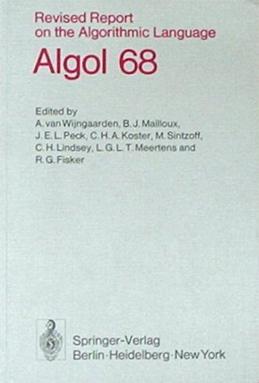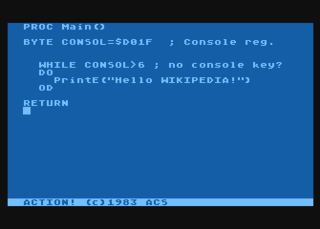
Erlang is a general-purpose, concurrent, functional high-level programming language, and a garbage-collected runtime system. The term Erlang is used interchangeably with Erlang/OTP, or Open Telecom Platform (OTP), which consists of the Erlang runtime system, several ready-to-use components (OTP) mainly written in Erlang, and a set of design principles for Erlang programs.

occam is a programming language which is concurrent and builds on the communicating sequential processes (CSP) process algebra, and shares many of its features. It is named after philosopher William of Ockham after whom Occam's razor is named.

Pascal is an imperative and procedural programming language, designed by Niklaus Wirth as a small, efficient language intended to encourage good programming practices using structured programming and data structuring. It is named in honour of the French mathematician, philosopher and physicist Blaise Pascal.
In computer science, communicating sequential processes (CSP) is a formal language for describing patterns of interaction in concurrent systems. It is a member of the family of mathematical theories of concurrency known as process algebras, or process calculi, based on message passing via channels. CSP was highly influential in the design of the occam programming language and also influenced the design of programming languages such as Limbo, RaftLib, Erlang, Go, Crystal, and Clojure's core.async.
Oz is a multiparadigm programming language, developed in the Programming Systems Lab at Université catholique de Louvain, for programming language education. It has a canonical textbook: Concepts, Techniques, and Models of Computer Programming.

ALGOL 68 is an imperative programming language that was conceived as a successor to the ALGOL 60 programming language, designed with the goal of a much wider scope of application and more rigorously defined syntax and semantics.
In computer science, the process calculi are a diverse family of related approaches for formally modelling concurrent systems. Process calculi provide a tool for the high-level description of interactions, communications, and synchronizations between a collection of independent agents or processes. They also provide algebraic laws that allow process descriptions to be manipulated and analyzed, and permit formal reasoning about equivalences between processes. Leading examples of process calculi include CSP, CCS, ACP, and LOTOS. More recent additions to the family include the π-calculus, the ambient calculus, PEPA, the fusion calculus and the join-calculus.

Per Brinch Hansen was a Danish-American computer scientist known for his work in operating systems, concurrent programming and parallel and distributed computing.

Action! is a procedural programming language and integrated development environment written by Clinton Parker for the Atari 8-bit family. The language, which is similar to ALGOL, compiles to high-performance code for the MOS Technologies 6502 of the Atari computers. Action! was distributed on ROM cartridge by Optimized Systems Software starting in 1983. It was one of the company's first bank-switched 16 kB "Super Cartridges".
In concurrent programming, a monitor is a synchronization construct that allows threads to have both mutual exclusion and the ability to wait (block) for a certain condition to become false. Monitors also have a mechanism for signaling other threads that their condition has been met. A monitor consists of a mutex (lock) object and condition variables. A condition variable essentially is a container of threads that are waiting for a certain condition. Monitors provide a mechanism for threads to temporarily give up exclusive access in order to wait for some condition to be met, before regaining exclusive access and resuming their task.
The actor model in computer science is a mathematical model of concurrent computation that treats an actor as the basic building block of concurrent computation. In response to a message it receives, an actor can: make local decisions, create more actors, send more messages, and determine how to respond to the next message received. Actors may modify their own private state, but can only affect each other indirectly through messaging.
The computer programming languages C and Pascal have similar times of origin, influences, and purposes. Both were used to design their own compilers early in their lifetimes. The original Pascal definition appeared in 1969 and a first compiler in 1970. The first version of C appeared in 1972.
Concurrent computing is a form of computing in which several computations are executed concurrently—during overlapping time periods—instead of sequentially—with one completing before the next starts.
In computer programming, an enumerated type is a data type consisting of a set of named values called elements, members, enumeral, or enumerators of the type. The enumerator names are usually identifiers that behave as constants in the language. An enumerated type can be seen as a degenerate tagged union of unit type. A variable that has been declared as having an enumerated type can be assigned any of the enumerators as a value. In other words, an enumerated type has values that are different from each other, and that can be compared and assigned, but are not specified by the programmer as having any particular concrete representation in the computer's memory; compilers and interpreters can represent them arbitrarily.
In computing, the producer-consumer problem is a family of problems described by Edsger W. Dijkstra since 1965.
Concurrent Pascal is a programming language designed by Per Brinch Hansen for writing concurrent computing programs such as operating systems and real-time computing monitoring systems on shared memory computers.
PROMELA is a verification modeling language introduced by Gerard J. Holzmann. The language allows for the dynamic creation of concurrent processes to model, for example, distributed systems. In PROMELA models, communication via message channels can be defined to be synchronous, or asynchronous. PROMELA models can be analyzed with the SPIN model checker, to verify that the modeled system produces the desired behavior. An implementation verified with Isabelle/HOL is also available, as part of the Computer Aided Verification of Automata (CAVA) project. Files written in Promela traditionally have a .pml file extension.
SuperPascal is an imperative, concurrent computing programming language developed by Per Brinch Hansen. It was designed as a publication language: a thinking tool to enable the clear and concise expression of concepts in parallel programming. This is in contrast with implementation languages which are often complicated with machine details and historical conventions. It was created to address the need at the time for a parallel publication language. Arguably, few languages today are expressive and concise enough to be used as thinking tools.
Pic Micro Pascala.k.a. PMP is a free Pascal cross compiler for PIC microcontrollers. It is intended to work with the Microchip Technology MPLAB suite installed; it has its own IDE (Scintilla-based) and it is a highly optimized compiler.
Join-patterns provides a way to write concurrent, parallel and distributed computer programs by message passing. Compared to the use of threads and locks, this is a high level programming model using communication constructs model to abstract the complexity of concurrent environment and to allow scalability. Its focus is on the execution of a chord between messages atomically consumed from a group of channels.






